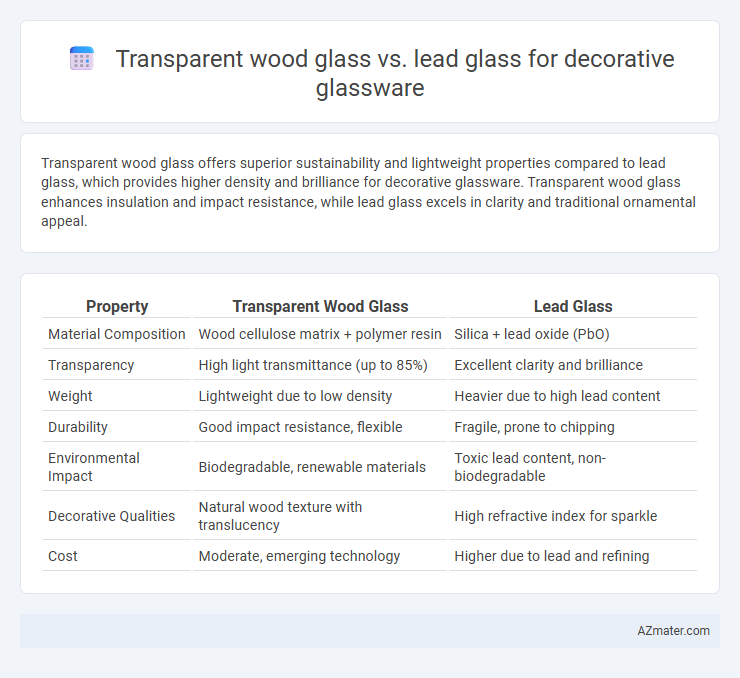Transparent wood glass offers superior sustainability and lightweight properties compared to lead glass, which provides higher density and brilliance for decorative glassware. Transparent wood glass enhances insulation and impact resistance, while lead glass excels in clarity and traditional ornamental appeal.
Table of Comparison
| Property | Transparent Wood Glass | Lead Glass |
|---|---|---|
| Material Composition | Wood cellulose matrix + polymer resin | Silica + lead oxide (PbO) |
| Transparency | High light transmittance (up to 85%) | Excellent clarity and brilliance |
| Weight | Lightweight due to low density | Heavier due to high lead content |
| Durability | Good impact resistance, flexible | Fragile, prone to chipping |
| Environmental Impact | Biodegradable, renewable materials | Toxic lead content, non-biodegradable |
| Decorative Qualities | Natural wood texture with translucency | High refractive index for sparkle |
| Cost | Moderate, emerging technology | Higher due to lead and refining |
Introduction to Transparent Wood Glass and Lead Glass
Transparent wood glass combines cellulose fibers with a polymer matrix to create a lightweight, strong material featuring natural wood aesthetics with high optical clarity. Lead glass, also known as lead crystal, contains lead oxide, enhancing its refractive index and brilliance, making it highly prized for decorative glassware due to its sparkle and weight. Both materials offer distinct visual and structural properties, with transparent wood glass emphasizing sustainability and modern design, while lead glass highlights traditional luxury and optical performance.
Material Composition and Manufacturing Processes
Transparent wood glass combines natural cellulose fibers with resin or polymer matrices, resulting in a lightweight, durable composite, while lead glass, primarily composed of silica, lead oxide, and other metal oxides, offers superior refractive properties. The manufacturing of transparent wood glass involves delignification of wood followed by polymer impregnation and curing, enhancing strength and transparency. Lead glass is produced through melting and slow cooling of raw materials to achieve clarity and brilliance essential for decorative glassware.
Aesthetic Qualities and Visual Appeal
Transparent wood glass offers a warm, natural texture with unique grain patterns that enhance the organic aesthetic of decorative glassware. Lead glass provides superior clarity and brilliance due to its high refractive index, creating dazzling light reflections and a classic, elegant appearance. The choice between transparent wood glass and lead glass depends on whether a rustic, tactile feel or a sparkling, refined visual appeal is desired.
Strength and Durability Comparison
Transparent wood glass exhibits exceptional strength and durability due to its natural fiber-reinforced composite structure, which provides high resistance to impact and bending compared to traditional lead glass. Lead glass, while known for its brilliance and clarity, is more brittle and prone to cracking under stress, making it less suitable for applications requiring enhanced mechanical performance. The superior toughness and lightweight nature of transparent wood glass make it an innovative alternative for decorative glassware demanding both aesthetic appeal and long-lasting durability.
Transparency and Light Transmission
Transparent wood glass offers high transparency with a natural wood texture that enhances light diffusion, creating a warm, soft glow suitable for decorative glassware. Lead glass is renowned for its ultra-clear transparency and superior light transmission, producing brilliant reflections and a sparkling effect ideal for luxury decorative pieces. Both materials optimize light transmission differently: transparent wood glass emphasizes a diffused, organic illumination while lead glass focuses on clarity and brilliance.
Environmental Impact and Sustainability
Transparent wood glass offers a renewable alternative to lead glass by utilizing sustainably sourced wood fibers and reducing reliance on toxic heavy metals, thereby decreasing environmental pollution and health risks. Lead glass production involves energy-intensive processes and generates hazardous waste due to lead content, posing long-term ecological and disposal challenges. Choosing transparent wood glass for decorative glassware promotes circular economy principles and significantly lowers carbon footprint compared to traditional lead glass.
Safety and Health Considerations
Transparent wood glass offers enhanced safety due to its non-toxic, biodegradable components and resistance to shattering, reducing injury risk compared to lead glass. Lead glass contains high levels of lead oxide, which poses health hazards through prolonged exposure or accidental ingestion, making it less suitable for food and drinkware. Choosing transparent wood glass for decorative glassware prioritizes user health by eliminating lead-related toxicity while maintaining aesthetic appeal.
Design Versatility for Decorative Glassware
Transparent wood glass offers superior design versatility for decorative glassware due to its lightweight nature and ability to be shaped into intricate forms while maintaining strength and durability. Its natural wood fibers provide unique texture and warmth, allowing artisans to create pieces with organic aesthetics not achievable with lead glass. Lead glass, known for its clarity and brilliance, excels in traditional ornate designs but lacks the adaptability to incorporate diverse textures and eco-friendly materials that transparent wood glass offers.
Cost Analysis and Market Trends
Transparent wood glass offers a cost-effective alternative to lead glass in decorative glassware, with lower raw material and manufacturing expenses due to its eco-friendly composites and simpler processing techniques. Market trends indicate a growing consumer preference for sustainable and lightweight materials, driving increased demand for transparent wood glass over traditional lead glass, which faces stricter regulations and higher production costs. The decorative glassware sector is witnessing accelerated innovation in transparent wood glass, leveraging its aesthetic appeal and environmental advantages to capture market share from conventional lead-based glass products.
Choosing the Right Glass for Decorative Applications
Transparent wood glass offers a unique combination of natural wood texture and transparency, providing an eco-friendly and lightweight alternative ideal for decorative glassware emphasizing sustainability and warmth. Lead glass, known for its high refractive index and brilliance, enhances light dispersion and clarity, making it a preferred choice for luxury glassware requiring dazzling visual effects. Selecting the right glass depends on desired aesthetic qualities, weight considerations, and environmental impact, with transparent wood glass suited for modern, organic designs and lead glass favored for traditional, high-end decorative pieces.

Infographic: Transparent wood glass vs Lead glass for Decorative glassware
 azmater.com
azmater.com